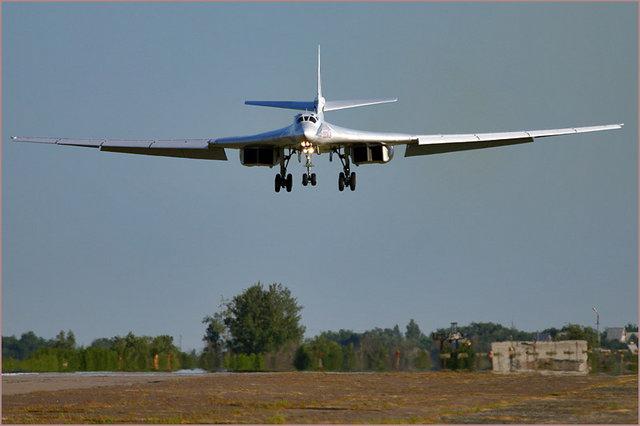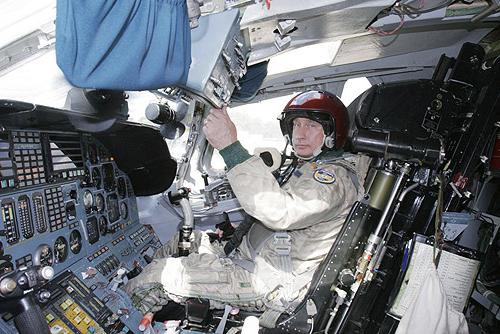History should have taught the American military leadership that any, the most expensive and technically sophisticated project, designed to put pressure on the USSR, and later the Russian Federation, provokes a desire to create a counteraction system or give a symmetrical answer. An example is the Tu-160, the White Swan, a strategic-purpose intercontinental missile bomber.
Tu-160 - the answer to the B-1
Since the mid-seventies in the United States began testing a new miracle of technology. Rockwell’s B-1 actually made an impression of a formidable car; this aircraft was built in compliance with all requirements of modern advanced aviation technologies. Variable wing geometry, supersonic sound (2.2 Mach), 34 tons of combat load, and a ceiling exceeding 18 thousand meters, all these characteristics provided the ability to convey 24 cruise missiles to a target located at a distance of 10 thousand kilometers. If it turns out that this is not enough, you can hang eight more from the outside. The project was advertised with a truly American scale, this flying cruiser was supposed to plunge the whole world into horror and despondency, but first of all the country of a potential adversary, citizens of the USSR and the Soviet military-political leadership. In the late seventies the arms race escalated . New high-tech threats have appeared:
- a neutron bomb that destroys all life with a minimum blast wave;
- cruise missiles flying low and inaccessible to Soviet radars;
- the latest carrier of the above means of destruction of B-1.
In many magazines, both foreign and Soviet, published the data of the American "Lancer" and his photo. Tu-160 "White Swan" in 1981 already made its first flights, but for the time being they did not tell anyone about it and did not print images in magazines.
Parameters of the Swan
The two planes are similar in appearance, the Tupolevs based on the proven American scheme. Four powerful engines that develop total thrust in afterburner up to 100,000 kgf are located under the wing on both sides of the fuselage. But the outward resemblance did not prevent the Tu-160 from being made much more powerful. The “White Swan”, a strategic missile carrier, can carry 45 tons of combat load, its ceiling is 21 thousand meters, and its flight range is almost 14 thousand km without refueling. Like the B-1, the crew consists of 4 people, and since the machine can be in the air for more than a day during combat duty, all comfort conditions are created for it, including sleeping places, a galley and other amenities. The Tu-160 "White Swan" airplane got its unofficial, but accustomed name not only for its elegant aerodynamic contours, but also for the color reflecting solar radiation in order to avoid overheating.
How to cut the "Swans"
In 1991, the USSR collapsed, which affected many aspects of the peaceful life of former Soviet citizens. To a large extent, this event also affected the defense capability of the republics that had previously constituted a single state. The "white swans" of the Tu-160 were divided into two "flocks", in Ukraine remained the 194th air regiment, which was armed with 19 units of strategic missile carriers. They stood idle for several years, and in 1998 they began to be cut into scrap metal in the presence of American senators, joyfully commenting on this event. There were two main reasons for this decision of the Ukrainian leadership. Firstly, there was no money for the operation and maintenance of expensive and complex aircraft. Secondly, Ukraine, with its non-aligned military doctrine , did not need the Tu-160 White Swan. Strategic weapons were massively disposed of, the same fate awaited mine launchers and other elements of the USSR missile shield. They managed to cut ten of the best and most powerful combat aircraft in the world.

Heroes turned into "White Swans"
The same reason why ten units of excellent Soviet-made aircraft were killed, ironically, turned out to be a saving factor for the remaining cars. They were exchanged for gas, which Ukraine had nothing to pay for. Six hundred cruise missiles, eight Bear-Bears Tu-95 and eight remaining Tu-160 White Swans were credited for $ 285 million in external debt. Strategic purpose equipment received a new location. It was the city of Engels, ancient Pokrovsk, located across the Volga from Saratov. One of the aircraft remained in Ukraine as a museum exhibit.

Having accepted their "birds", the Russian Air Force disposed of them in a businesslike manner. Cars are in excellent technical condition, undergo modernization and from time to time make long-haul flights (as in 2008 to Venezuela, for example). Almost all of them, like sea cruisers, except onboard numbers, have their own names in honor of prominent people, such as General Ermolov, Nikolai Kuznetsov, Valery Chkalov and others. Among them are Ilya Muromets and the great aircraft designer Andrei Tupolev.